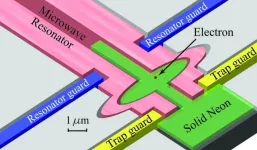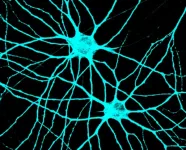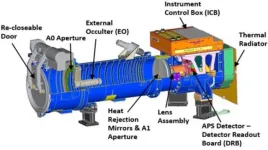(Press-News.org) Quantum computers have the potential to be revolutionary tools for their ability to perform calculations that would take classical computers many years to resolve.
But to make an effective quantum computer, you need a reliable quantum bit, or qubit, that can exist in a simultaneous 0 or 1 state for a sufficiently long period, known as its coherence time.
One promising approach is trapping a single electron on a solid neon surface, called an electron-on-solid-neon qubit. A study led by FAMU-FSU College of Engineering Professor Wei Guo that was published in Physical Review Letters shows new insight into the quantum state that describes the condition of electrons on such a qubit, information that can help engineers build this innovative technology.
Guo’s team found that small bumps on the surface of solid neon in the qubit can naturally bind electrons, which creates ring-shaped quantum states of these electrons. The quantum state refers to the various properties of an electron, such as position, momentum and other characteristics, before they are measured. When the bumps are a certain size, the electron’s transition energy — the amount of energy required for an electron to move from one quantum ring state to another — aligns with the energy of microwave photons, another elementary particle.
This alignment allows for controlled manipulation of the electron, which is needed for quantum computing.
“This work significantly advances our understanding of the electron-trapping mechanism on a promising quantum computing platform,” Guo said. “It not only clarifies puzzling experimental observations but also delivers crucial insights for the design, optimization and control of electron-on-solid-neon qubits.”
Previous work by Guo and collaborators demonstrated the viability of a solid-state single-electron qubit platform using electrons trapped on solid neon. Recent research showed coherence times as great as 0.1 millisecond, or 100 times longer than typical coherence times of 1 microsecond for conventional semiconductor-based and superconductor-based charge qubits.
Coherence time determines how long a quantum system can maintain a superposition state — the ability of the system to be in multiple states at the same time until it is measured, which is one characteristic that gives quantum computers their unique abilities.
The extended coherence time of the electron-on-solid-neon qubit can be attributed to the inertness and purity of solid neon. This qubit system also addresses the issue of liquid surface vibrations, a problem inherent in the more extensively studied electron-on-liquid-helium qubit. The current research offers crucial insights into optimizing the electron-on-solid-neon qubit further.
A crucial part of that optimization is creating qubits that are smooth through most of the solid neon surface but have bumps of the right size where they are needed. Designers want minimal naturally occurring bumps on the surface that attract disruptive background electrical charge. At the same time, intentionally fabricating bumps of the correct size within the microwave resonator on the qubit improves the ability to trap electrons.
“This research underscores the critical need for further study of how different conditions affect neon qubit manufacturing,” Guo said. “Neon injection temperatures and pressure influence the final qubit product. The more control we have over this process, the more precise we can build, and the closer we move to quantum computing that can solve currently unmanageable calculations.”
Co-authors on this paper were Toshiaki Kanai, a former graduate research student in the FSU Department of Physics, and Dafei Jin, an associate professor at the University of Notre Dame.
The research was supported by the National Science Foundation, the Gordon and Betty Moore Foundation, and the Air Force Office of Scientific Research.
END
Understanding quantum states: New FAMU-FSU research shows importance of precise topography in solid neon qubits
2024-06-26
ELSE PRESS RELEASES FROM THIS DATE:
Review of pathogenesis, research and treatment of amyloidosis published in New England Journal of Medicine
2024-06-26
(Boston) — AL (immunoglobulin light chain) amyloidosis is a rare disease that often results in progressive organ dysfunction, organ failure and eventual death.
Clonal plasma cells in the bone marrow secrete free light chains into circulation. These light chains are part of immunoglobulins, also called antibodies. But in this disease, light chains misfold and aggregate into amyloid fibrils that deposit in organs and tissues.
In a review article of AL amyloidosis “Systemic Light Chain Amyloidosis,” Vaishali Sanchorawala, MD, director of the Amyloidosis Center at the Chobanian & ...
New research tools reveal the dynamics behind breaking a sweat
2024-06-26
Excessive heat across the United States is making this summer a season of sweat. Perspiration and its evaporation are crucial to keeping us cool when things get hot. But our understanding of how sweat evaporates is limited to the profuse phases of the process, when our bodies are coated in a sticky film or even pools of perspiration. Relatively is little is known about the dynamics behind initial phases of sweating, when tiny droplets are emitted by individual sweat glands and then quickly evaporate.
“There are mechanical engineering researchers around the world, myself included, who are devoted to understanding the different parameters of droplet behavior on ...
Neuroscience research leverages stem cells to understand how neurons connect and communicate in the brain
2024-06-26
Newly published research from Colorado State University answers fundamental questions about cellular connectivity in the brain that could be useful in the development of treatments for neurological diseases like autism, epilepsy or schizophrenia.
The work, highlighted in the Proceedings of the National Academy of Sciences, focuses on how neurons in the brain transmit information between each other through highly specialized subcellular structures called synapses. These delicate structures are key to controlling many processes across the nervous system via electrochemical ...
NRL CCOR launches on the GOES-U NOAA satellite to monitor space weather
2024-06-26
WASHINGTON – The U.S. Naval Research Laboratory’s (NRL) Compact Coronagraph (CCOR) was launched June 25, on the National Oceanic and Atmospheric Administration (NOAA) Geostationary Operational Environmental Satellite-U (GOES-U) from NASA – Kennedy Space Center to detect and characterize coronal mass ejections (CMEs).
The NOAA sponsored NRL to design, integrate, and test CCOR, a small space telescope that will create an artificial eclipse of the sun and ...
Study shows how liver damage from stress and aging might be reversible
2024-06-26
DURHAM, N.C. – While the liver is one of the body’s most resilient organs, it is still vulnerable to the ravages of stress and aging, leading to disease, severe scarring and failure. A Duke Health research team now might have found a way to turn back time and restore the liver.
In experiments using mice and liver tissue from humans, the researchers identified how the aging process prompts certain liver cells to die off. They were then able to reverse the process in the animals with an investigational drug.
The finding, which ...
Bone stem cells with IFITM5 mutation get caught in a loop leading to osteogenesis imperfecta type V
2024-06-26
A study conducted by researchers at Baylor College of Medicine and collaborating institutions reveals the molecular events leading to osteogenesis imperfecta type V, a form of brittle bone disease caused by a mutation in the gene IFITM5.
The mutation blocks the normal development of bone stem cells into mature cells, which would form healthy bones. Instead, the mutation leads to the formation of bones that are extremely brittle. Children with this disorder have recurrent fractures, bone deformities, chronic pain and other complications. ...
Tai Chi reduces risk of inflammatory disease, treats insomnia among breast cancer survivors
2024-06-26
New research led by UCLA Health confirms that both Tai Chi and cognitive behavioral therapy can reduce insomnia in breast cancer survivors but also may provide additional health benefits by reducing inflammation and bolstering anti-viral defenses.
Chronic insomnia is one of the most prominent symptoms experienced among cancer survivors and poses significant health concerns, including the risk of inflammatory disease that could increase the risk of cancer recurrence.
About 30% of breast cancer survivors are reported to have insomnia, which is twice the rate of the general population. While previous research has shown cognitive behavioral therapy and mind-body ...
Technology presented for measuring carbon in media, advertising and generative AI
2024-06-26
Measuring energy consumption derived from digital activity from a scientific point of view is the challenge faced by Hiili, S.L., a company recently formed and driven by two researchers from the Universidad Carlos III de Madrid (UC3M), Ángel and Rubén Cuevas Rumín, from the Telematics Engineering Department. Specifically, they develop technological solutions that combine Internet measurement techniques and Artificial Intelligence (AI) to make an accurate estimate of the energy consumption of a company's ...
Do people who exercise more have a lower risk of ALS?
2024-06-26
EMBARGOED FOR RELEASE UNTIL 4 P.M. ET, WEDNESDAY, JUNE 26, 2024
MINNEAPOLIS – Moderate levels of physical activity and fitness may be linked to a reduced risk of amyotrophic lateral sclerosis (ALS) later in life, according to a new study published in the June 26, 2024, online issue of Neurology®, the medical journal of the American Academy of Neurology. The study only found an association between physical activity and risk of ALS in male participants, not female participants.
ALS is a rare, progressive neurodegenerative disease that affects nerve cells in the brain and the spinal cord. People with ALS lose the ability to initiate ...
Could preventative drug be effective in people with migraine and rebound headache?
2024-06-26
EMBARGOED FOR RELEASE UNTIL 4 P.M. ET, WEDNESDAY, JUNE 26, 2024
MINNEAPOLIS – A drug used to prevent migraine may also be effective in people with migraine who experience rebound headaches, according to a new study published in the June 26, 2024, online issue of Neurology®, the medical journal of the American Academy of Neurology.
People with chronic migraine who overused pain medication had fewer monthly migraine and headache days and fewer days using pain medication when taking the migraine prevention drug atogepant.
“There is a high prevalence of pain medication ...




